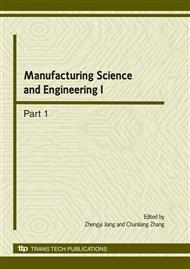p.324
p.328
p.332
p.337
p.344
p.348
p.357
p.361
p.365
Improvement of Hole Flanging Product Forming Process Using Finite Element Simulation
Abstract:
Flanging is a method of sheet metal forming process under combined compressive and tensile conditions using a punch and die to raise closed rims (flanges or collars) on pierced holes. For the flanging product used for the automotive steering part, the thickness of the bottom radius area is very important because of the crack usually occurred during the using process. But during conventional flanging process, the thickness of the rim and the bottom radius area were decreased seriously and make the hole flanging not strong enough to be used. In order to increase the thickness of bottom radius area of the flanging wall, a new method that combines flanging process and cold forging process was proposed in this paper and a special forming die set was designed with a stripper subjected to counter-pressure with an aim to obtain a more substantial flange. FEM software DEFORM 3D was employed to simulate these flanging part forming processes. The results showed the thickness of bottom radius area of the flanging wall was increased and a more substantial flange was obtained.
Info:
Periodical:
Pages:
344-347
Citation:
Online since:
March 2010
Authors:
Keywords:
Price:
Сopyright:
© 2010 Trans Tech Publications Ltd. All Rights Reserved
Share:
Citation:


